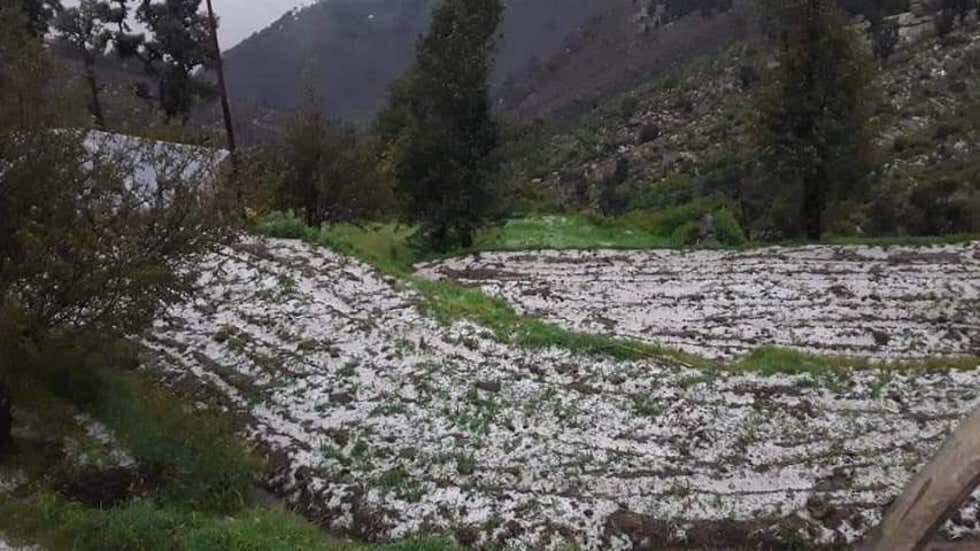
© IANSJammu's farmers distraught as unseasonal hailstorms destroy crops
"Every time we go out for hoeing the maize saplings, the rain and hailstorms start. Till now, our net sown area of around 5 kanals of land has been devastated by unseasonal hailstorms four times," said an anxious-looking Guddo Devi.
The 26-year-old was preparing the firewood to make dinner for her three children while speaking about the calamity. She lives in the remote Pounsa hamlet in the Chenani Tehsil of Jammu's Udhampur district, and like her, many farmers in the surrounding areas of Udhampur have lost their crops to hailstorms.
In these winter zones, farmers often cultivate only one crop a year in the autumn, and this loss has left them anxious about surviving the cold months ahead.
Usually, it does not hail in Jammu in June! This year, however, unseasonal rainfall and hailstorms have wreaked havoc in the region by damaging standing crops in hundreds of kanals (1 kanal is equal to 0.125 acres) in the winter areas of Udhampur district.
Agriculture in Jammu's hillsUnlike the plains of Jammu, where maize crop is sown in May-June and harvested in mid-September, in Jammu's winter zone areas, maize kernels are sown in April, Baisakhi festival, and harvested in October.
The winter zone areas include Udhampur's Pounsa, Satyalta, Malaal, Patnitop, Panchairi, Dudu-Basantgarh, Kulwanta, Pattan, Latti and major parts of Doda, Ramban, Reasi, Kishtwar, and Kathua districts.
During winters, most people in Jammu's upper reaches either grow mustard that can withstand negative temperatures. If not, they do not grow anything since they receive heavy snowfall between December and March. So, most farmers in the hills of Jammu do farming for sustenance, unlike in the plains where farmers grow commercial crops twice or thrice a year on vast and fertile lands.
Since most people in Jammu's higher reaches grow only one crop in a year, once the harvesting is done in October, they take up labour work in winter in Udhampur town, Jammu, Amritsar and Delhi.
"But this year and the last, my five brothers and I couldn't even earn from labour work due to the pandemic," said Bittu Ram, 53, from the Malaal area in Satyalta village. His crops suffered massive damage due to the hailstorms.
"I have around 15 kanals (1.875 acres) of agricultural land, and I grow maize, rajma (kidney beans) and amaranthus seeds during Baisakh (April) month every year. Normally it rains in May-June in our hills, but hail is not normal. The four to five recent hailstorms have completely uprooted the maize saplings that we had grown two months back."
There are 30 households in the remote Malaal village of Satyalta panchayat. The maize crop of all the Malaal residents got completely ravaged by the recent hailstorms.
The unseasonal hailstormsAccording to Sonam Lotus, head of Jammu and Kashmir Meteorological Department, the hailstorms in Jammu and Kashmir are "not unseasonal". "Rather, their frequency has increased due to more local developments this year," he told 101Reporters.
Explaining the local developments, he said, "The months of April and May have been categorised as 'hot weather months' by the Indian Meteorological Department (IMD). In this period, India's northern region, including J&K, experiences thunderstorms, hailstorms accompanied by gusty winds due to western disturbances and local developments, particularly convection."
"This year, the frequency of these western disturbances and local convection was very high, resulting in more hailstorms and hence more damage to the crops in the higher reaches of Jammu," explained the weather scientist.
When asked if the frequency of windstorms and hailstorms will increase with the advent of monsoon in July in Jammu and Kashmir, he said, "This phenomenon cannot be predicted."
Massive crop lossesYash Pal, the sarpanch (village head) of Satyalta Panchayat, which has a population of around 3,000, said that the panchayat has 17,000 kanals of total agricultural land. He said that maize, rajma, amaranthus, pumpkin, beans and other hilly crops are grown on about 10,000 kanals of land.
"Around 90 per cent of these 10,000 kanals of agricultural land has suffered damages due to the hailstorms and incessant rainfall this year," claimed Pal.
When asked if he had approached the administration to assess the losses so that farmers could be compensated, the Panchayat head replied, "Our area is not motorable. So government officials hardly visit our hilly villages. They assess the losses on mobile phones only. I've briefed our patwari (local revenue official) on the phone. Let's see how much they pay the affected farmers."
Speaking to 101Reporters, Abdul Majid, the patwari of Patwar Halqa Satyalta, admitted that some of the hilly areas in Satyalta had suffered extensive damages due to hailstorms.
"Our teams are on their toes to assess the losses. A detailed report shall be prepared and sent to higher-ups," he said, adding, "Most probably, by September, the farmers would be compensated."
Kewal Kumar, a farmer in Ramnagar Tehsil's hilly Basantgarh block, said the hailstorms had badly damaged crops in Basantgarh, Dudu, Pachond-I, Pachond-II, and Jakhed areas. "Maize, rajma, amaranthus, French beans, squash, apricot, walnut, and apple crops have been destroyed. While vast lands in Basantgarh hills have suffered crop damages, farmers in low-lying areas are not able to sow the maize and other crops due to recurring hailstorms," he explained.
**
The above article has been published from a wire source with minimal modifications to the headline and text.IANS / TWC India
Comment: Jammu and Kashmir suffer heavy losses to orchards due to hailstorms